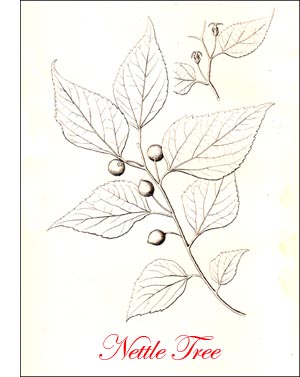Hackberry ot Nettle Tree or Sugar Berry Tree
 Hackberry, Nettle Tree, Sugar Berry (Celtis occidentalis, Linn.)-Tree, 50 to 125 feet, with slender trunk and round head, of very slender, bushy twigs and pendulous branches. Bark light brown or pale grey, broken into thick warts or scales by deep furrows; branches often corrugated and warty. Wood light yellowheavy, soft, coarse, weak. Buds axillary, never terminal; acute, ovate, small. Leaves simple, alternate, ovate, 2 1/2 to 4 inches long, often fulcate, oblique at base, serrate above widest part, entire below it; thin, deep green, with downy lining; 3-nerved, from slim petiole; autumn colour yellow. Flowers, May, monoecious, or mixed, greenish, axillary staminate, clustered at base of season's shoot; pistillate solitary, in axils of leaves, green, with spreading, 2-horned stigma. Fruits, September, oblong, thin, fleshed berry, 4 to z inch long, purple, sweet; hangs all winter. Preferred habitat, moist soil along streams or marshes. Distribu-tion, Southern Canada west to Puget Sound; south to Florida, Tennessee, Missouri, Texas and New Mexico. Uses: Planted for shade and ornament. Wood used for cheap furniture and fencing.
Hackberry, Nettle Tree, Sugar Berry (Celtis occidentalis, Linn.)-Tree, 50 to 125 feet, with slender trunk and round head, of very slender, bushy twigs and pendulous branches. Bark light brown or pale grey, broken into thick warts or scales by deep furrows; branches often corrugated and warty. Wood light yellowheavy, soft, coarse, weak. Buds axillary, never terminal; acute, ovate, small. Leaves simple, alternate, ovate, 2 1/2 to 4 inches long, often fulcate, oblique at base, serrate above widest part, entire below it; thin, deep green, with downy lining; 3-nerved, from slim petiole; autumn colour yellow. Flowers, May, monoecious, or mixed, greenish, axillary staminate, clustered at base of season's shoot; pistillate solitary, in axils of leaves, green, with spreading, 2-horned stigma. Fruits, September, oblong, thin, fleshed berry, 4 to z inch long, purple, sweet; hangs all winter. Preferred habitat, moist soil along streams or marshes. Distribu-tion, Southern Canada west to Puget Sound; south to Florida, Tennessee, Missouri, Texas and New Mexico. Uses: Planted for shade and ornament. Wood used for cheap furniture and fencing.It is easy to mistake the hackberry for an elm. The habit of the two trees leads the casual observer astray. It takes a second look to note the finer spray of the hackberry twigs, its more horizontal, less drooping branches. The warty bark is characteristic. The little axillary sugar berries are very different from elm samaras. There are few months in the year when fruits are not to be found, green or ripe, on the tree. They are the delight of birds throughout hard winters. A peculiarity of the foliage is the apparent division of the petiole into three ribs instead of a single midrib. Otherwise the leaf is elm-like, though smaller and brighter green than that of the American elm.
The hackberry is not familiarly known by people in the regions where it grows. Else it would be transplanted more commonly to adorn private premises and to shade village streets. There is no danger in digging up well-grown trees, for the roots are fibrous and shallow, and carry an abundance of soil with them.
The beauty of the hackberry's graceful crown is sometimes marred by a fungus which produces a thick tufting of twigs at the ends of branches. These are called "witches' brooms." Growths of similar appearance are produced by insects on other trees.
Nettle Tree picture